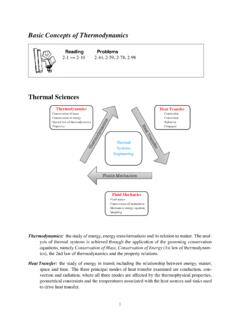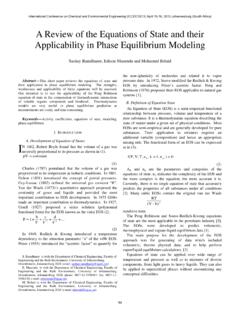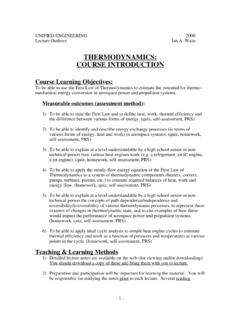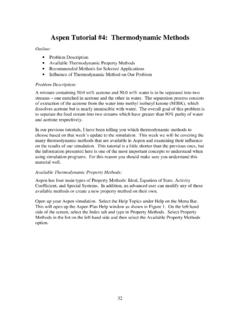Transcription of Thermodynamics and Kinetics of Adsorption
1 Thermodynamics and Kinetics of Adsorption subtitle: What can we learn about Adsorption systems from thermodynamic and kinetic measurements? IMPRS-Lecture Series 2012: Experimental and Theoretical Methods in Surface Science'. Klaus Christmann Institut f r Chemie und Biochemie, Freie Universit t Berlin Organization 1. Introduction; terms and definitions 2. Thermodynamics of Adsorption Adsorption as a macroscopic (thermodynamic) phenomenon equilibrium Thermodynamics and Adsorption isotherms: Langmuir and BET isotherm The Adsorption energy: Initial Adsorption energy and a-priori heterogeneity Coverage dependence of the Adsorption energy: lateral interactions and a-posteriori heterogeneity 3.
2 Kinetics of Adsorption and desorption The rate of Adsorption ; trapping and sticking The rate of desorption; order of desorption and frequency factor The desorption energy: Binding states and lateral interactions Experimental procedure and evaluation of TD spectra 4. Summary and conclusions Practical relevance of Adsorption processes Technical applications of Adsorption : Separation processes of gaseous and liquid mixtures via molecular sieves Heterogeneous catalysis Chemical analyses (various types of chromatography). Flotation processes Gas mask filters Lubrication phenomena Optical coatings corrosion-resistant coatings (Lotus effect). As we will see later, one distinguishes chemical Adsorption (chemisorption).
3 And physical Adsorption (physisorption), depending of the strengths of the interaction between adsorbent and adsorptive. While chemisorption is most essential for heterogeneous surface reactions, physisorption plays a major role during separation and enrichment processes at and near phase boundaries. 1. Terminology: Strength of interaction forces - physisorption and chemisorption Interaction forces responsible for adsorptive bonds Kind of interaction Strength of interaction van-der-Waals Very weak (usually less than 50 kJ/mole). ionic Strong (Coulombic origin). > 100 kJ/mole covalent Strong (quantum-chemical origin). > 50 kJ/mole metallic Strong (quantum-chemical origin), E > 50 kJ/mole 1.
4 Terminology: Adsorption and desorption e e t In heterogeneous catalysis, Adsorption and desorption are essential elementary processes because Adsorption activates the decisive chemical bonds of the reactants and desorption removes the reaction products from the surface. In a typical Adsorption process, a foreign material in gaseous or liquid form (the adsorptive) becomes attached to a solid or liquid surface, the adsorbent, and forms the adsorbate, a complex between adsorptive and adsorpt. Consequence: No Adsorption without a surface (or, more generally, without a phase boundary including liquid surfaces). In heterogeneous catalysis we mostly deal with solid surfaces. Since the adsorptive and the adsorbent often undergo a chemical reaction, the chemical and physical properties of the adsorbate is not always just the sum of the individual properties of the adsorptive and the adsorbent, but often represents a phase with novel properties.
5 1. Terminology: what is a surface? There exist a lot of definitions among which the most rigorous ones are: A surface represents the outer or the topmost boundary of a solid or liquid object, where the bulk properties are no longer sufficient to describe the system s properties. A surface is the boundary between the inner and outer world of a given phase. A surface always determines a thermodynamic phase boundary, where the physical and chemical properties of the adjacent phases change abruptly. Consequence: In the surface region, the interaction forces responsible for the bulk properties become asymmetric, since the outermost bonds are unsaturated, resulting in a peculiar chemical reactivity of the surface.
6 In our context the most important consequence is that the surface becomes capable of adsorbing foreign atoms or molecules. 1. Terminology: asymmetry of binding forces Consequences: Clean surfaces try to rearrange their atoms positions in order to minimize the surface free energy. One distinguishes: multilayer relaxation, , in the surface region the distances perpendicular to the surface differ from those of the bulk reconstruction, , the surface atoms take on new periodic positions parallel to the surface (formation of superstructures). Both phenomena can (and usually will) be affected by Adsorption . Asymmetry of binding forces and its consequence Adsorbate-induced surface reconstruction Free energy as a function of the surface configuration.
7 This configuration is determined by the adsorbate coverage. At a critical value of this coverage, the surface flips to a more stable equilibrium configuration. 1. Terminology: surfaces of interest We shall subdivide our surfaces in two classes: Single crystal surfaces are geometrically well-defined. While they are not really used in heterogeneous catalysis, they have the advantage to provide access to the physics and chemistry of the elementary steps of a catalytic reaction ( model systems ). The scientific field of classical Surface Science - introduced among others, by Gerhard Ertl - can be most successfully applied. Polycrystalline, heterogeneous surfaces are very important in practical heterogeneous catalysis, since they have a large surface area due to micro-, meso- or macropores.
8 Among these solids are charcoal (active carbon), alumina, silica, zeolites or carbon nanotubes. Adsorption on these porous Pconcave < p0 < pconvex surfaces is often well described by the BET Adsorption isotherm. In addition, the existence of mesopores (pore radius p 2 V . rp) can modify the thermodynamic phase equilibria due to a = exp m .. RT rp , Kelvin . vapor pressure depression or elevation predicted by the Kelvin p0. equation (curvature effect). The Kelvin equation, which contains both the size and the surface tension of the dispersed Kelvin equation material also governs growth and nucleation phenomena (Ostwald ripening etc.). Terminology: associative and dissociative Adsorption Associative (molecular) Adsorption leaves the adsorbing molecule intact.
9 Example: CO Adsorption on a palladium(100) surface. The Adsorption energy equals the depth of the potential energy well: Ead = Echem. Dissociative (atomic) Adsorption cleaves the adsorbing molecule either homolytically (H H = H + H ) or heterolytically (H H = H- + H+). Example: H2 Adsorption on a nickel (111) surface. The Adsorption energy is the difference between twice the Ni H bond energy and the heat of H2 dissociation (435 kJ/mol): Ead = 2 EMe-H - Ediss CO-Pd interaction potential H2-Ni interaction potential Information on the mechanism of Adsorption may be obtained from measurements of Adsorption isotherms or from thermal desorption spectra as will be discussed later. Terminology: associative and dissociative Adsorption The dissociation of a diatomic molecule can be better characterized by a two-dimensional potential energy representation.
10 In these so-called elbow-plots the perpendicular distance of the molecule, y, is plotted against the internuclear distance, x. Whether or not the molecule can successfully dissociate depends on its translational and/or vibrational excitation. early barrier late barrier Terminology: associative and dissociative Adsorption The dissociation of molecular hydrogen has been studied theoretically in great detail, for example on Pd(100) surfaces by A. Gro . et Quite important is the so-called dynamical steering' where the H2. molecule is guided to the optimum dissociation sites. Terminology: activated and non-activated (spontaneous) Adsorption In the adsorbed state and in thermal equilibrium the trapped particle resides at the bottom of the potential well.









